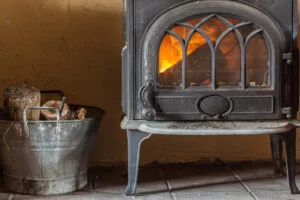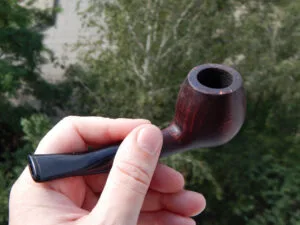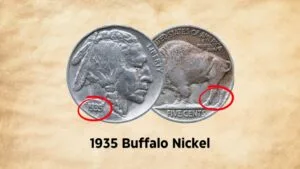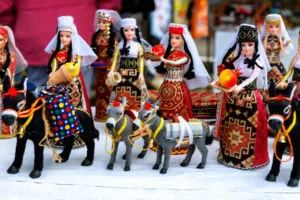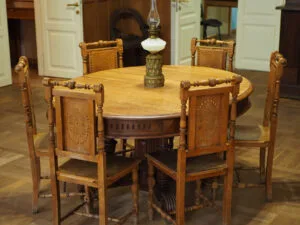If you are a racing freak, you must be following VKA, aka Vintage Karting Association. These are the same clubs that exhibit go-karts and pay handsome returns of up to $2500!
The only condition is that your go-kart must be vintage!
But you might not want to get a go-kart just for the club, right? So, in this case, you can appraise your go-kart for its vintage features and resell it back once you are done racing. So, let’s find out some clues and features to identify these precious antique go-karts!
Key Takeaways
- Old go-karts didn’t have superior engines, brakes, or safety features. Plus, their joints were simply bolted or lashed.
- Vintage go-karts have three types of engines – Mc-Culloh, Water cooled, and Electric. Of these, the Mc-Culloh ones are old and precious.
- If you want an old and precious go-kart, look for extra features like brake pedals, drum brakes, and a 2-cycle chassis.
- Get branded go-karts with branded tires for the best returns. And you can check the kart’s walls, inner rims, chassis, and steering for the logo.
Distinctive Features of a Vintage Go Kart
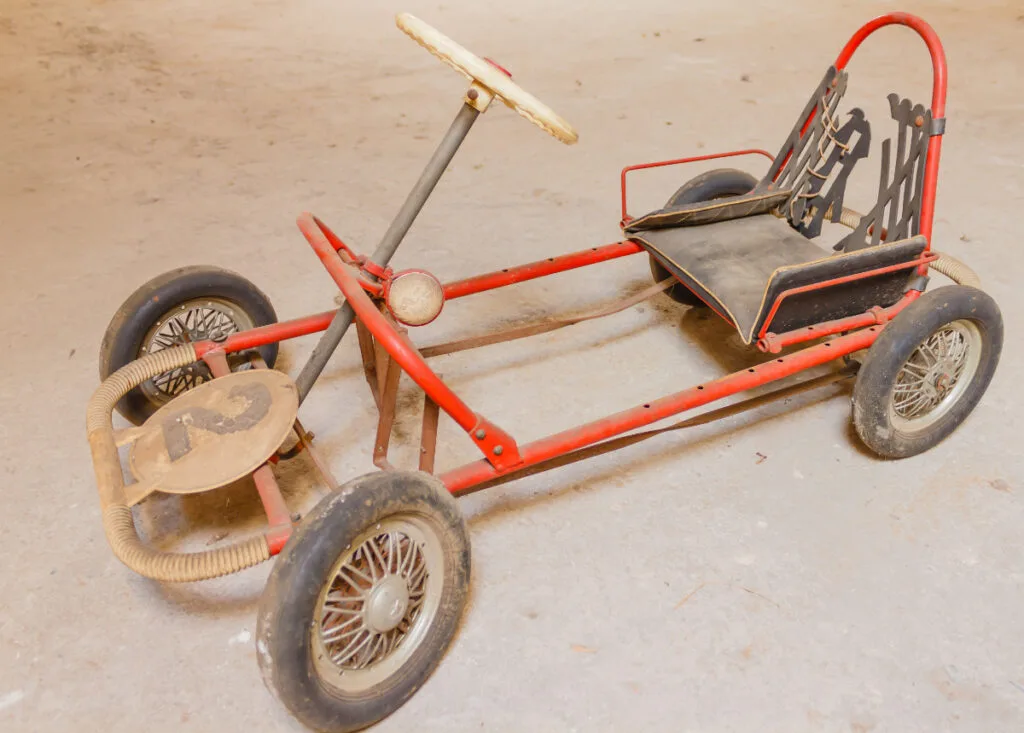
A go-kart will generally have engines, clutches, brakes, and wheels. But in vintage go-karts, you can expect low, 2-cycle power engines like West Bend and McCullock, and the following features:
- Small metal or cast-iron tube frames with inhouse welding or bolting
- Spoked rims or tires with rubber insulators
- Wooden or metal steering wheels and throttle pedals
- Painted body cage or roll shell with floral stickers or motifs
- Simple braking systems – Drum or Band brakes with hydraulic cylinders
A Brief History of Go-Karts
You might know that vintage go-karts have chassis and engines. But can you guess the engine of the first go-kart? Well, it was that of a lawnmower! It so happened that Art Ingels didn’t want to invest more in this play model. So, he used a tube chassis and hand brakes.
But this simple play model had no name nor any publicity. In fact, it was in the 1960s that ‘Duffy Livingston’ coined the name go-kart and made this model public. He also added some extra features like seats and double brakes.
And now, there was no full stop! People went crazy over this new sport and started go-kart clubs and events. And for that, makers had to improvise the model once again! So, powerful engines, disc brakes, and hydraulic systems came to use.
In the next few years, i.e. in the 1980s and 1990s, the focus was on light and faster go-karts. So, steel karts were common, and those old, hand-chiseled ones became rare.
3 Types of Antique Go-Karts & Their Values
Just like other antiques, vintage go-karts underwent many changes in design and fuel, leading to three main types as follows:
1. Mc-Culloch MC-10 Powered Go-karts (1960s)
These are one of the first go-kart models to use powered McCulloch engines and brakes. So, they obviously had powerful brakes and speeds. But these had about 5” magnesium wheels and two-piece frames that increased friction. But they still cost up to $1,000.
2. Water Cooled Engine Go-karts (1980s)
Water-cooled karts look the same as any other gas go-kart. It’s just that they have high-pressure water coolers to lower the temperature and friction. And you can actually spot them by all their hoses, disc brakes, and radiators. So, you can price one for $300 – 1000.
3. Electric Go Karts (1990s)
As the name implies, these go-karts run on electricity. So, they don’t have any gas tanks or tubes and are light and fast. You’ll also find covered 60V batteries, upholstered seats, and rubber-coated steering with this. But these are new and a bit affordable, up to $600.
6 Main Factors to Assess Antique Go-Karts Value
If you thought that an antique go-kart’s value depends only on gas and fuel, you might be wrong. In fact, there are six factors that decide a vintage go-kart’s final resell price!
1. Vintage Go-kart’s Date & Age
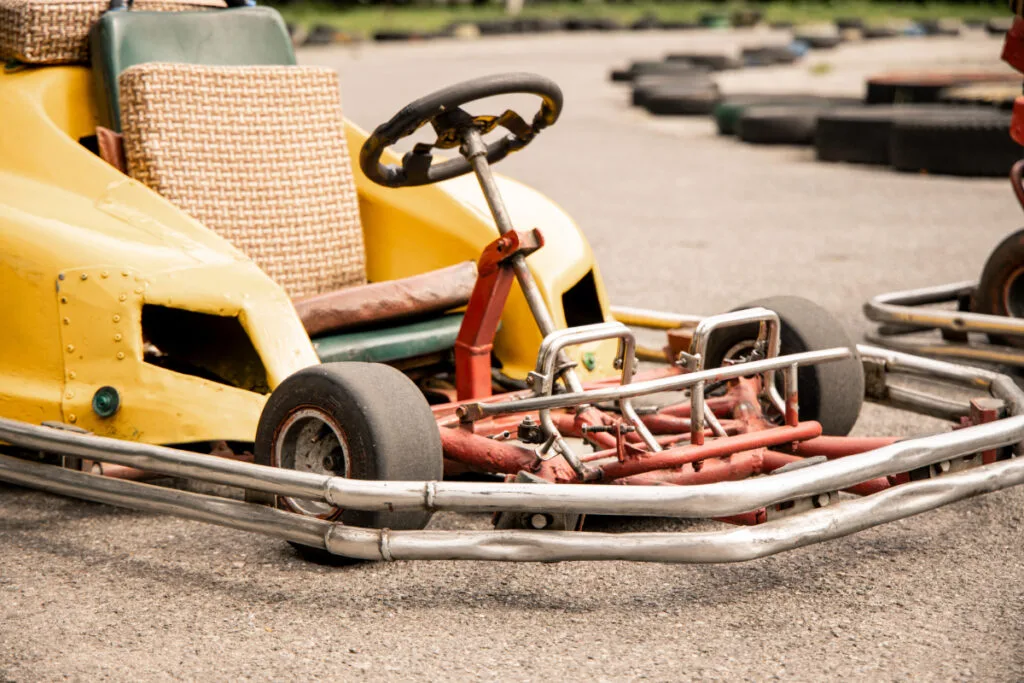
Unlike other antiques, vintage go-karts aren’t handmade. But still, you can find notable differences in the 1950s – 1980s models. For example, the first go-karts had wood seats and gas engines, while the later ones were electric. So, their design changed, and so did the cost! Let’s see how:
The 1960s Go-Karts
You can easily spot the 1960s go-karts by their wood or alloy bodies and plank seats. Besides that, look for their two-stroke gasoline engines, centrifugal clutches, and drum brakes. In fact, you’ll even see a brake pedal on the driver’s left.
Now, unscrew the rubber tires and check their axles. If they have solid rears, you can price your piece for $200 – 900. But, if they just have wheels, $180 – 300 is enough.
The 1980s Go-Karts
If your vintage go-kart has superior machinery like water engines, disc brakes, and clutches, it’s most likely an old 1980s go-kart. Such karts have high-speed rubber tires, threads, and torsion bars. Plus, they might be branded pieces. So, they are expensive, up to $1000.
The 1990s Go-Karts
Most of the 1990s go-karts were commercial and mass-produced. So, they have more complex traits like steel or metal walls, springs, and torsion bars. You’ll also find soft rubber or tube tires to reduce friction. But since they are new and common, they cost up to $400.
| Year | Age | Serial Number | Estimated Valuation |
| 1982 | 41 years | 90425, B90125, or 87542 (Numbers for Margay Karts) | $150 – 300 |
| 1990s | 33 years | US #105 (Hurricane Karts) | $500 – 2000 |
| 1990s | 33 years | A94 (Golf Karts) | $300 – 1700 |
Look for a go-kart chassis with alcohol engines or cable brakes to spot an old make.
2. Antique Go-kart Materials
Now, let’s identify the material of your vintage go-kart! For that, just lift the frames and check the material on its walls, chassis, wheels, and hubs. Then, you can simply match it with the table below to estimate the value:
| Old Go-kart Materials | Top Features | Average Cost |
| Wooden Go-karts | Sold pink or mahogany walls, ply or composite frames, iron wheels, hubs, and engine mounts with rubber seals | $500 – 1700 |
| Metal Go-karts | Thin aluminum or steel walls, brass or bronze bushings, rubber tires, and engine mounts | $900 – 4000 |
| Vinyl Go-karts | Fiberglass or vinyl bodywork, rubber grips, vibration dampeners, and plastic seats | $240 – 1000 |
Pick go-karts with brushed paint and oxidized or alloyed finishes for the best returns.
3. Old Go kart Tire Brands
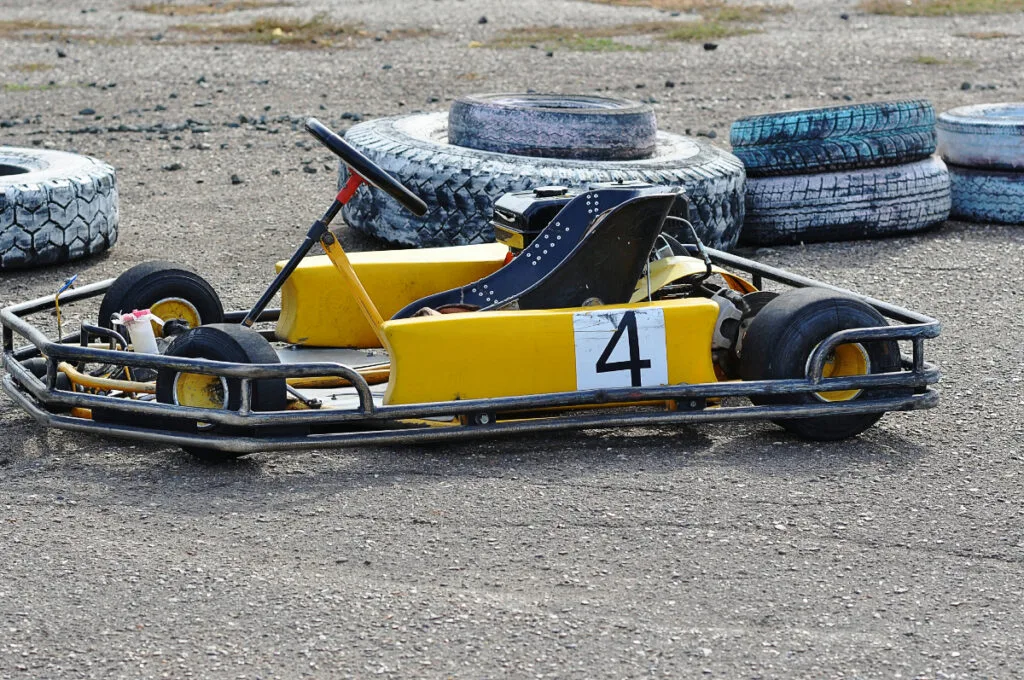
If you want an antique, ribbed tire go-kart for your car collection, look for the ones with typical Carlisle or Goodyear tires. But if you are more into racing and speed, new, Dunlop ones might be perfect! Also, try to get narrow, grooved tires for an old make.
You’ll mostly get the tire names on the inside rim of your wheel. But if that’s not there, check the features from the table below:
| Old Go-kart Tire Brands | Average Size | Top Features | Average Cost for Each Tire (Please add this value to your go-kart’s base price) |
| Carlisle Tires | 11 X 3.5 – 5, 11 X 4.5 | Classic car tires with round profiles and ribbed treads | $30 – 40 |
| Goodyear Tires | 11 X 6 | Blue strip on the sidewall, Grooved threads, and Single sidewinders | $40 – 50 |
| Dunlop Tires | 11 X 5, 11 X 7.1 | Black sidewalls, slick treads, and ribs | $45 – 50 |
4. Vintage Go-kart Brands
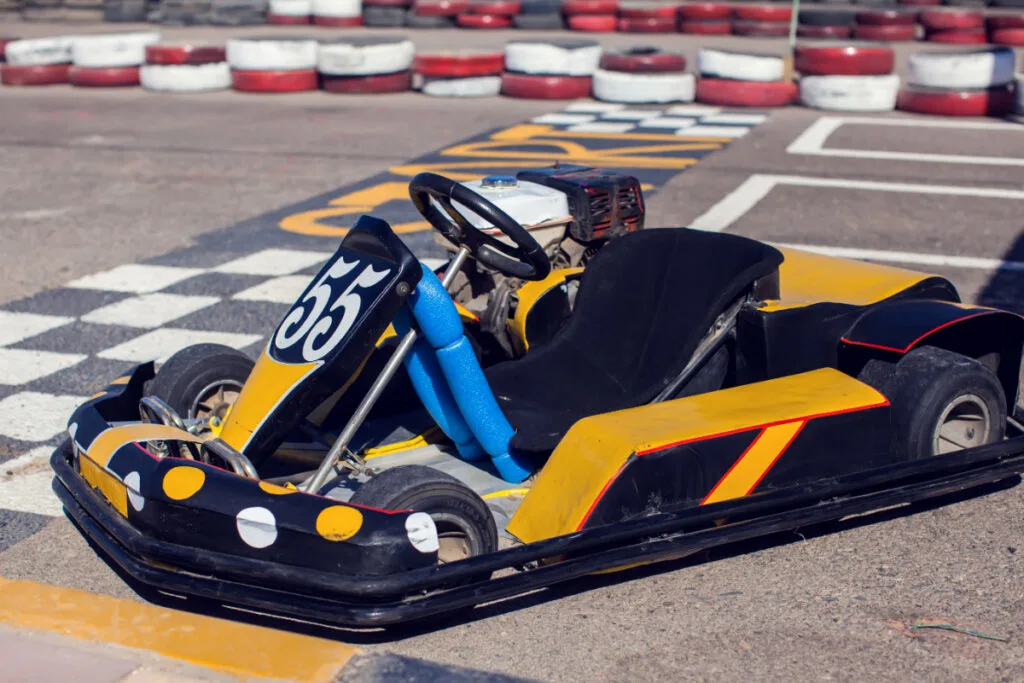
Want to save all the fuss on identifying old go-kart features and their prices? Here’s a trick! Just check for any stamped logo or brand name on its rear body. If yes, note its name, and check the brand’s catalog for the resale price.
Other than that, you can also refer to the official Vintage Kart Registry for more brand names!
Here is a go-kart price chart based on brands for help:
| Old Go-Kart Brands | Key Features | Estimated Price (for pieces with NO Damage) |
| Fox Manufacturing & Co. (1950) | Go-Boy series of karts with high-power, double-cycle engines | $600 – 4000 |
| Mc-Culloh (1940s) | Mc-10 engines, drum brakes, and spoked wheels | $300 – 1000 |
| Margay (1960s) | Rear-mounted, four-stroke engines, adjustable casters, and fiberglass bodies | $1000 – 3500 |
| Rupp (1950s) | Dart Cart or Recreational models like snowmobiles and mini bikes | $2000 – 5000 |
| Coyote (1960s) | High-quality chassis, racing pedigree, and high-voltage motors | $500 – 1500 |
Avoid getting old, unusable go-karts with punctured tires, broken seats, and scratched chassis, as they might lose their value by 10 – 12%.
5. Vintage Go-Kart Chassis Design
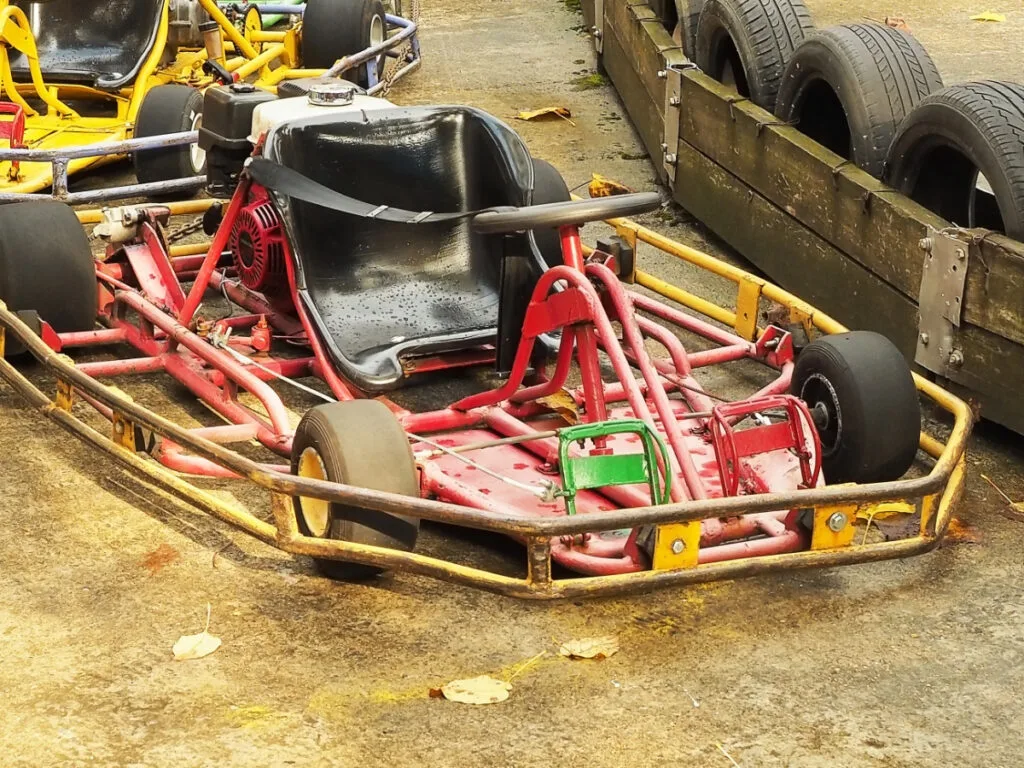
Vintage chassis designs are simple! I mean, you’ll just see ladder frames, angle bars, and channels. And even the joints will be simply bolted, glued, or lashed.
On the contrary, you’ll see a much more refined chassis in the post-1970s models. Like, for example, they will have channel bars, welded joints, and round tubes. But they’ll obviously have a lower value than the 1960s karts.
6. Go-Kart Braking System
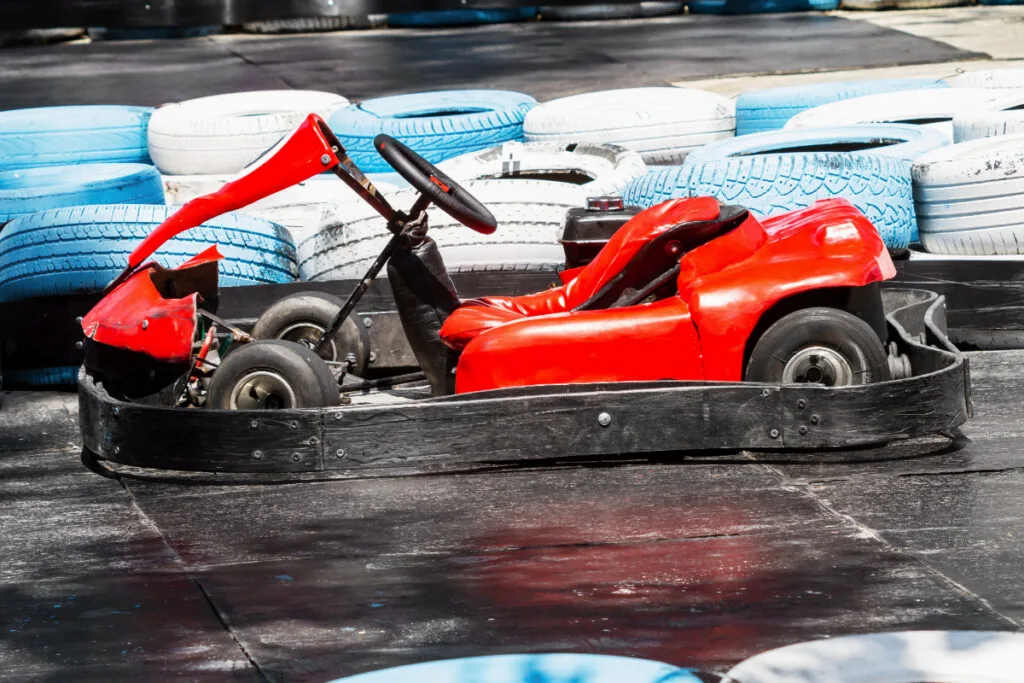
Most of the vintage go-karts didn’t have any brakes at all! So, users just had to rely on flat land to reduce their speed. Yes, you’ll see drum brakes in some medieval models, but those won’t be that efficient.
So, if your go-kart has power disc brakes, remember that it’s a new 1980s model, and price it accordingly.
Do Vintage Go-Karts Have a VIN Number?
Most post-1980s go-karts have a VIN (Vehicle Identification Number) on the driver or passenger seat frames. But if it’s not there, you can always track its serial number.
What Oil Should I Use for My Vintage Go-Kart?
You can use professional machine oils like 5W-20 Synthetic oil, Castor Oil, or Stroke Kart oil to lubricate any vintage go-kart.
Can You Power Wash a Vintage Go Kart?
Yes, you can powerwash a vintage go-kart, but keep the wand at least 3-4 feet away to avoid damage. Also, cover the air filters, seals, and bearings with a plastic film before washing.
So now that you have our guide, we hope that you’ll be able to spot your go-kart features and appraise them! Just remember to check the brands, serial numbers, and materials to age them. Also, try to pick usable or restored models for more value.
And if you are a car freak, even other antiques like ‘pedal cars’ and ‘carjacks’ might interest you! So, let’s learn more!
Note: This article is intended for informational, educational, and entertainment purposes only. Some images are illustrative and may not represent actual brands, products, or related entities. All trademarks, product names, brand logos, packaging, and other intellectual property referenced remain the exclusive property of their respective owners. Any brand mentions or references are provided solely for descriptive and educational context and do not imply any formal or commercial association.


